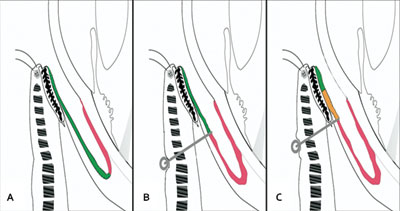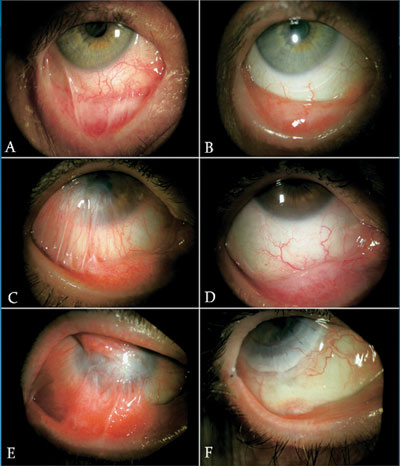Amniotic membrane transplantation can be useful in symblepharon lysis surgery
 Thomas John |
Introduction
Symblepharon refers to adhesion, either partial or complete, of the palpebral conjunctiva of the eyelid to the bulbar conjunctiva of the eyeball. Such adhesions between the bulbar and palpebral conjunctiva can result in ocular motility restrictions, diplopia, incomplete eyelid closure, and entropion with secondary deleterious effects on the ocular surface, including the cornea. Any conjunctival infection (bacterial or viral conjunctivitis) or allergic conjunctivitis (vernal or atopic conjunctivitis) with secondary scarring can result in the formation of symblepharon. Additionally, it can be a complication of disease state as in dry eye syndrome, cicatricial pemphigoid, Stevens-Johnson syndrome, erythema multiforme, toxic epidermal necrolysis or secondary to chemical burn. It can also be seen in severe cases of recurrent pterygium.
The management of symblepharon can be challenging. In this column, Drs. Sheha and Tseng describe the use of preserved human amniotic membrane with or without oral mucosa in symblepharon lysis and ocular surface reconstruction surgery.
– Thomas John, MD
OSN Surgical Maneuvers
Editor
A variety of approaches have been tried for the successful surgical management of chronic symblepharon. Various materials have been evaluated as a mechanical barrier to keep potentially adhesive surfaces apart after excision of the symblepharon. Popular alternatives include conjunctival autograft and mucous membrane grafts. However, these suffer from the disadvantages of difficulty in harvesting, limited availability and potential complications at the donor site.
Amniotic membrane transplantation (AMT) has been performed as a therapy for a variety of ocular surface disorders and is known to be highly effective in both promoting re-epithelialization and suppressing inflammation. Amniotic membrane provides a new basement membrane that helps in the migration of epithelial cells, reinforces adhesion of basal epithelial cells, promotes epithelial differentiation and prevents epithelial breakdown. It also down-regulates TGF-beta signaling, responsible for fibroblastic activation in wound healing. This inhibits fibroblast proliferation and prevents subconjunctival fibrosis, and hence the recurrence of symblepharon. In addition, graft rejection is unlikely, as amniotic membrane does not express HLA-A, -B or -DR antigens.
Several investigators reported the use of amniotic membrane as an alternative substrate for ocular surface reconstruction after removal of symblepharon. The lack of a clear strategy for deploying amniotic membrane may explain the varying degrees of success that have been obtained. We found that additional use of intraoperative mitomycin C significantly enhanced the success of AMT. We propose the following algorithm of surgical strategies for ocular surface reconstruction after symblepharon lysis by selectively using AMT, MMC and oral mucosal graft.
Surgical techniques
Surgery is performed under either general or local anesthesia. Adequate exposure is obtained with either a lid speculum or lid traction sutures. The conjunctival incision is made along the ends of the symblepharon and undermined from the Tenon’s capsule to allow the conjunctiva to retract to its normal anatomical position. A traction suture near the exposed bulbar sclera allows better exposure and subsequent excision of cicatrix. The subconjunctival fibrous tissue is excised to the maximum extent possible, and any adhesions around the muscle are released. For eyes with inflammatory activity, sponges soaked in 0.04% MMC are inserted into the deep fornix for 3 to 5 minutes.
Ocular surface reconstruction is performed using amniotic membrane transplant to cover the bare sclera, to reform the fornix and to cover the denuded palpebral conjunctiva up to the edge of the recessed symblepharon conjunctiva. The surgical techniques are described according to the severity of the cases (Figures 1 and 2).
 Figure 1. Three surgical strategies for fornix reconstruction. (A) After symblepharon lysis and removal of subconjunctival scar tissue, (red) amniotic membrane was used to cover the denuded scleral surface with fibrin glue or sutures up to the (green) recessed conjunctiva in mild symblepharon. (B) One (gray) anchoring suture per quadrant was used to secure the (green) recessed conjunctival edge to the skin with a (gray circle) bolster in moderate symblepharon. (C) Additional oral mucosa (orange) was used to extend the epithelial covering from the (green) residual conjunctiva in severe symblepharon. Images: Sheha H, Tseng SCG
|
 Figure 2. Photographs showing the fornix reconstruction after symblepharon lysis and AMT. (A) Mild symblepharon resulting from chronic cicatricial conjunctivitis. (B) A deep and noninflamed fornix, 20 months after symblepharon lysis, intraoperative MMC and AMT using fibrin glue. (C) Moderate symblepharon resulting from chemical burn. (D) Same eye 23 months after symblepharon lysis, intraoperative MMC, AMT using fibrin glue and anchoring suture. (E) Severe symblepharon resulting from chemical burn. (F) Twenty-three months after symblepharon lysis, intraoperative MMC administration, AMT using fibrin glue and anchoring suture. This procedure allowed successful keratolimbal allograft. |
Mild cases: The recessed conjunctiva is large enough to cover the palpebral area, where it is secured using Tisseel fibrin glue (Baxter). The bare sclera is covered with amniotic membrane, stromal side down, using fibrin glue or sutures (Figure 1a).
Moderate cases: The recessed conjunctiva is just enough to cover the tarsal area. A double-armed 4-0 black silk suture, secured to the skin with a bolster, is needed to keep it in place. One such anchoring suture is needed per quadrant. The remaining bare sclera, fornix and palpebral area are covered by amniotic membrane using fibrin glue (Figure 1b).
Severe cases: There is not enough of the recessed conjunctiva to cover the tarsal area. Therefore, oral mucosal graft is used to substitute the tarsal conjunctiva. Oral mucosal graft is secured to the tarsal plate with fibrin glue, sutured to the posterior lid margin using 8-0 Vicryl sutures and then anchored to the skin with a bolster as previously described. The remaining bare sclera, fornix and palpebral area are covered with amniotic membrane in the same manner (Figure 1c).
Finally, the excess amniotic membrane and fibrin gel are trimmed to make the graft flush with the conjunctival or oral mucosal graft edges. Temporary tarsorrhaphy is recommended in severe cases to minimize eye exposure that may interfere with healing.
After surgery, patients should receive ointment containing topical antibiotic and steroid four times a day for 2 weeks and then taper off over the next few weeks. Healing is confirmed by fluorescein staining, and the fornix-forming sutures are removed after 2 weeks.
References:
- Jain S, Rastogi A. Evaluation of the outcome of amniotic membrane transplantation for ocular surface reconstruction in symblepharon. Eye. 2004;18(12):1251-1257.
- Kaufman HE, Thomas EL. Prevention and treatment of symblepharon. Am J Ophthalmol. 1979;88(3 Pt 1):419-423.
- Kheirkhah A, Blanco G, Casas V, Hayashida Y, Raju VK, Tseng SC. Surgical strategies for fornix reconstruction based on symblepharon severity. Am J Ophthalmol. 2008;146(2):266-275.
- Tseng SC, Espana EM, Kawakita T, et al. How does amniotic membrane work? Ocul Surf. 2004;2(3):177-187.
- Thomas John, MD, is a clinical associate professor at Loyola University at Chicago and is in private practice in Tinley Park and Oak Lawn, Ill. He can be reached at 708-429-2223; fax: 708-429-2226; e-mail: tjcornea@gmail.com.
- Hosam Sheha, MD, PhD, can be reached at hsheha2010@gmail.com.
- Scheffer CG Tseng, MD, PhD, can be reached at stseng@ocularsurface.com. Dr. Tseng is a shareholder of TissueTech, which owns U.S. patents 6,152,142 and 6,326,019 on the method of preparation and clinical uses of human amniotic membrane and ProKera, distributed by Bio-Tissue.

